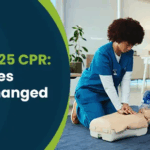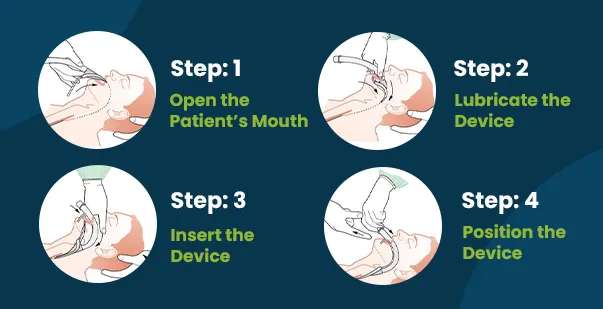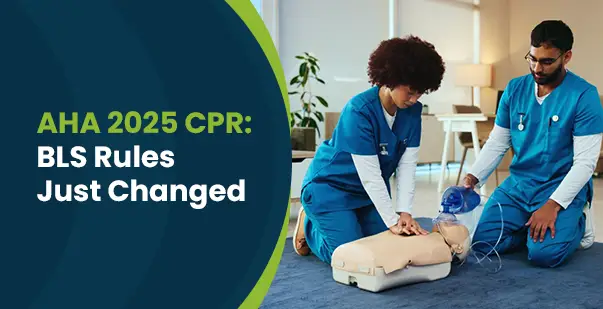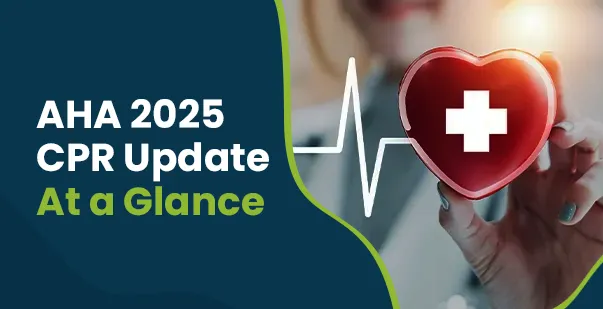In emergency and surgical settings, ensuring a secure airway is crucial for patient survival. Supraglottic Airway (SGA) devices have revolutionized airway management by offering a quick and effective alternative to endotracheal intubation. Whether in pre-hospital care, operating rooms, or critical care units, these devices provide a lifeline when traditional intubation is challenging or time-sensitive.
For instance, imagine a paramedic responding to a cardiac arrest where intubation is difficult due to limited visibility or an obstructed airway. In such cases, an SGA device like the i-gel® or Laryngeal Mask Airway (LMA) can be swiftly inserted, ensuring adequate ventilation and oxygenation without the need for direct laryngoscopy.
So, read on to learn about the types of SADs, what an advanced airway is, how to prepare and insert them, and how to care for them after use.
What Are Supraglottic Devices?
Supraglottic devices are a group of advanced airway devices used to manage a patient’s airway without needing a tube inserted into the windpipe. They are placed at the back of the throat (pharynx) to support breathing, provide oxygen, or deliver anesthetic gases. These devices are often used during surgeries or emergencies. SADs are placed above the glottis, the part of the throat containing the vocal cords. The glottis is an anatomical structure found in the larynx. It is particularly located between the subglottis and supraglottis. It contains the vocal cords (true vocal folds) and also the rima glottidis. These devices do not pass through the vocal cords, which makes them less invasive than endotracheal tubes.
SADs create a seal around the airway, preventing aspiration (the entry of stomach contents into the lungs). Some devices, like the i-gel® and certain Laryngeal Mask Airways (LMAs), use a soft, gel-like cuff that molds to the throat, while others, like the LMA ProSeal®, have an inflatable cuff that provides a tighter seal. This mechanism ensures that air enters the lungs rather than the stomach and helps protect against regurgitated material from reaching the lungs.
SGAs are handy in three main situations: They can be the primary tool for airway management, act as a backup when a face mask doesn’t work well, or guide a breathing tube into the airway. A study shows that supraglottic devices and intubation are successful in 65% to 100% of patients with difficult airways. Furthermore, SADs can be placed more easily than ETTs (Endotracheal Tubes), which are often used during emergencies.
Both Supraglottic Airway Devices (SADs) and Endotracheal Tubes (ETTs) secure the airway but differ in placement and use. SADs sit above the vocal cords in the pharynx (back of the throat), creating a seal for ventilation, while ETTs are inserted directly into the trachea. They provide a more secure airway but require more skill to place.
SADs are faster and easier to insert, making them ideal for emergencies, anesthesia, and pre-hospital care.
How Many Types of Supraglottic Airway Devices Exist?
SADs are commonly used in surgeries, cardiac arrests, and situations where securing the airway is a priority. These advanced airways are especially useful in emergencies when healthcare providers need to act quickly. Some of the most common types of SADs are discussed as follows:
Laryngeal Mask Airway (LMA)
This device is shaped like a small mask that fits over the laryngeal opening. It allows oxygen and anesthetic gases to pass directly to the lungs. It is widely used in surgeries and emergencies because it is simple to place and effective. LMA is the right option for offering rescue ventilation to unconscious patients. The device can also be employed as a rescue gadget for difficult airways.
Esophageal-Tracheal Combitube (ETC)
The ETC is a double-lumen tube designed for emergencies when securing the airway is critical. One tube delivers oxygen to the lungs, while the other prevents air from entering the stomach. It is often used in pre-hospital and emergency settings. The ETC is an ideal tool for emergency airway management.
I-gel
The I-gel is a soft, gel-like device that fits snugly without needing inflation. It seals the airway and reduces the risk of injury. It is popular for its quick placement and reliable seal. I-gel is used in countless clinical settings and has a first-attempt success rate of 88.2% to 90%.
King LT Airway
This single-lumen device has cuffs that block the esophagus and seal the airway. It ensures proper ventilation and prevents stomach contents from entering the lungs. It is commonly used by paramedics and in pre-hospital emergencies. King LT is best used during emergencies and it is inserted instantly, roughly within 10 seconds to 25 seconds.
When Supraglottic Airway Devices Are Indicated To Use?
Supraglottic airway devices (SADs) are especially useful in certain clinical and emergency situations where securing the airway is important. Below are the main situations where doctors use SADs to maintain the patient’s airway:
- SADs are used when a person is unconscious and cannot breathe adequately. They help open the airway and ensure oxygen reaches the lungs. SADs, at times, are used in the form of backup when other tools like endotracheal tubes or face masks don’t work.
- SADs are a safe alternative to inserting a breathing tube into the windpipe in less invasive or shorter surgeries. They provide effective airway management while being less invasive for the patient.
- In emergency cases where intubation cannot be performed quickly or safely, SADs are a life-saving option. They are faster and easier to use than intubation.
- SADs are also ideal for short medical procedures where the patient is sedated. They keep the airway open without the need for more invasive methods.
- If attempts to insert an endotracheal tube fail, SADs provide an alternative to secure the airway. They are an essential tool in difficult airway management.
Healthcare professionals must be well-trained to use SADs correctly. Improper use can lead to complications or ineffective airway support. Training ensures these devices are used safely and efficiently. Besides that, many physicians decide when it’s the correct time to use such tools.
Read more: All You Need to Know About Tachypnea, its Causes, and Symptoms
How To Prepare The Patient For Using A Supraglottic Airway Device?
Preparing a patient for a supraglottic airway device (SAD) is crucial to ensure safety and success. It involves checking the patient’s condition, choosing the right device, and positioning them properly. Careful preparation helps prevent complications and makes the process smoother for both the patient and caregiver. Below are some important steps explained:
Assess the Patient
Make sure the patient is unconscious and needs help with breathing. Check the mouth and throat for any objects, swelling, or injuries that may block the airway. If you find any obstructions, clear them before proceeding. It’s vital to check the vital signs in patients, such as oxygen levels and heart rate. That way, it aids in assessing their readiness for airway management.
Choose the Right Device
Select a supraglottic airway device that fits the patient. The size and type of the device depend on the patient’s weight, age, and condition. Using the correct size reduces complications and improves the device’s effectiveness.
Gather All Necessary Equipment
Prepare everything you need to perform the procedure. This includes the chosen supraglottic airway device, a syringe (if the device requires cuff inflation), a water-based lubricant for smooth insertion, and a bag valve mask to assist with ventilation.
Check the Device
Check the supraglottic airway device thoroughly before use. Look for any visible damage, like tears or cracks. If the device has an inflatable cuff, use a syringe to inflate it and ensure it holds air without leaking. This step ensures the device works correctly during the procedure.
Position the Patient
Place the patient in the correct position to allow easy and safe insertion. If possible, use the “sniffing” position, where the head is slightly tilted back and the chin is lifted. If the patient cannot be moved, use a neutral head position. This helps align the airway for better access.
Importance of Preparation
Following these steps carefully ensures the supraglottic airway device is used correctly and reduces the risk of complications. Proper preparation can save time and improve patient outcomes during an emergency.
Steps for Inserting a Supraglottic Airway Device
Inserting a supraglottic airway device (SAD) is a serious procedure. It helps provide an open airway for patients who cannot breathe on their own. To ensure proper placement, follow these steps carefully.
Step 1: Open the Patient’s Mouth
Gently open the mouth using the “crossed-finger” technique. Place your thumb on the lower teeth and your index finger on the upper teeth. Open the mouth wide enough to insert the device without causing injury.
Step 2: Lubricate the Device
Apply a water-based lubricant to the SAD’s surface to reduce friction during insertion. Use just enough to coat the device evenly. Avoid excess lubricant, as it might interfere with proper placement or block the airway.
Step 3: Insert the Device
Hold the SAD in your dominant hand and gently guide it into the mouth. Follow the natural curve of the throat during insertion. If you feel resistance, stop and check the placement, don’t push harder, as this could injure the patient’s airway.
Step 4: Position the Device
Push the device until you feel resistance, which indicates it has reached the proper position. Ensure it aligns with the patient’s airway anatomy for effective ventilation and minimal risk of complications.
Step 5: Inflate the Cuff (if required)
If the SAD has an inflatable cuff, use a syringe to inflate it with air. Follow the manufacturer’s instructions for the correct volume. Overinflation can harm the airway, so inflate carefully to create a secure seal.
Step 6: Secure the Device
Fix the SAD in place with tape or a strap. It should be stable to avoid movement during ventilation. Attach a bag-valve mask or a ventilator to the device. This will allow oxygen delivery to the patient’s lungs.
Step 7: Confirm Proper Placement
After placing the SAD, ensure it is functioning correctly. Check if the chest rises and falls while ventilating the patient. This shows that air is reaching the lungs. Listen to breath sounds on both sides of the chest using a stethoscope for equal air entry.
Step 8: Listen for Breath Sounds
Use a stethoscope to listen to both sides of the chest. Equal breath sounds indicate correct placement. You can also use a pulse oximeter to check the patient’s oxygen saturation. An increase in oxygen levels confirms effective ventilation. Ensure no air escapes around the SAD. Air leaks may indicate poor positioning or cuff issues.
Read More: Hyperventilation: Causes, Treatments, and Prevention
Probable SAD Complications and How to Avoid Them
Supraglottic airway devices (SADs) are generally safe and effective, but complications can still happen. Understanding these risks and learning how to avoid them is essential for patient safety. This should also be done when the patient can protect their airways and is stable and awake. It will also be a perfect idea to have the suction equipment ready if regurgitation takes place.
Airway Obstruction
If the SAD is not positioned correctly, airway obstruction can occur. To prevent this, ensure the device is placed properly, and the cuff is inflated to the recommended pressure. After inserting the device, always check for proper airflow.
Aspiration
Aspiration occurs when stomach contents enter the lungs. This is a serious complication. SADs should be used carefully in patients with a full stomach. Avoid use if the patient has eaten recently. This lowers the chance of regurgitation and aspiration.
Trauma to the Mouth or Throat
Improper insertion can cause injury to the mouth or throat. To avoid this, insert the SAD gently and ensure it is well-lubricated. Never force the device into place.
Air Leaks
Air leaks can reduce the effectiveness of the SAD. These happen if the cuff is not inflated to the correct volume or the device does not fit well. Always check the cuff pressure and confirm a proper fit before use.
How to Reduce Risks
Regular training in the correct use of SADs can help prevent complications. Practicing insertion techniques and understanding the risks can improve patient outcomes. Always follow the manufacturer’s guidelines for the device you are using.
How to Remove a Supraglottic Airway Device?
A supraglottic airway device (SAD) is removed when the patient no longer needs airway support. As the device involves the airway, proper removal is important to prevent complications. For a safe removal, follow these steps carefully:
Check the Patient’s Condition
Ensure the patient is awake or easily arousable. Confirm they are breathing normally and can protect their airway. Protective reflexes like coughing, swallowing, or throat clearing must return before attempting removal. This ensures the airway remains clear after the device is removed.
Deflate the Cuff (if applicable)
If the SAD has an inflatable cuff, use a syringe to deflate it carefully. The rapid loss of deflation will lead to sudden loss of airway tone or injury. Make sure all the air is removed from the cuff to allow smooth and safe extraction.
Remove the Device
Gently ask the patient to open their mouth wide. Carefully remove the SAD, following the natural curve of the airway. Never force removal if the patient is biting the device. Wait until they relax or respond to commands. During certain situations, gentle jaw relaxation methods can be used if the patient is cooperative and awake.
Monitor the Patient
Keep a close eye on the patient after the SAD is removed. Watch for signs of difficulty breathing, coughing, or discomfort. Check their oxygen levels using a pulse oximeter. Be prepared to address any complications that may arise afterward.
The Importance of Training and Practice while Using SADs
Proper removal requires skill and practice. Therefore, healthcare providers must be trained to handle SADs safely. They should also be aware of the complications and take immediate action if necessary. The best approach is to enroll in a hands-on training program. This program builds the skills needed to handle real-life emergencies confidently and efficiently.
Staying updated on the latest airway management guidelines is equally important. Technology and best practices change often, so being informed helps providers choose the right tools. This consistent effort ensures patient safety and reduces risks in high-pressure situations.
Use Supraglottic Airway Devices Effectively With the Right Steps!
Supraglottic airway devices are important in managing airways safely and efficiently. They are easy to use, quick to insert, and less invasive than traditional intubation methods. By following the correct steps and guidelines, healthcare providers can use these devices effectively.
The key to success with SADs lies in thorough training, careful preparation, and attention to detail. When healthcare providers are equipped with the right skills and knowledge, they can manage airways confidently and respond to emergencies swiftly.
FAQs
- What is a Supraglottic Airway?
A supraglottic airway (SAD) is a medical device used to maintain an open airway. It is placed above the vocal cords, which allows air to flow into the lungs without needing intubation. SADs are commonly used in surgeries and emergencies to provide effective ventilation.
- What is the difference between intubation and supraglottic airway?
Intubation involves inserting a tube directly into the trachea to secure the airway, while a supraglottic airway rests above the vocal cords without entering the trachea. Intubation offers greater protection but requires more skill. However, SADs are easier to use and suitable for shorter, less complex procedures.
- When should you use a supraglottic airway?
A supraglottic airway is used when intubation is not required or feasible. It is ideal for short surgeries and in emergencies requiring quick airway management, or to treat patients with difficult airways. SADs provide ventilation without invasive procedures. Thus, they are used in many non-critical situations.
- What are the concerns with the supraglottic airway?
Some of the common concerns associated with supraglottic airway include the risk of aspiration, inadequate ventilation, or airway obstruction. Moreover, improper placement can cause injury or complications. Therefore, SADs are not suitable for long-term use or patients with high aspiration risks.









